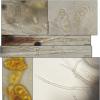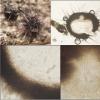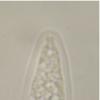
30-12-2025 16:44
Pascal DucosBonjour,Une anamorphe rose stipitée, très nombre

30-12-2025 17:14
 Bernard CLESSE
Bernard CLESSE
Bonjour à toutes et tous,Pourriez-vous aider Albe

29-12-2025 10:15
Hulda Caroline HolteHello, I found and collected this propoloid ascom

30-12-2025 09:04
Hello.A Pyrenomycete sprouting sparsely but very d

29-12-2025 17:44
Isabelle CharissouBonjour,J'aimerais savoir si d'autres personnes au

12-11-2021 00:03
Lepista ZacariasHi everybody,A week ago in my fiels trip I noticed

29-12-2025 17:12
 Bernard CLESSE
Bernard CLESSE
Bonjour à toutes et tous,Pourriez-vous m'aider à
Niessliaceae?
Gernot Friebes,
06-01-2010 16:29
here I have a pyrenomycet which grew on a branch of Juglans. The hyaline to slightly brownish hair are a very nice contrast to the black ascomata. Due to these hairs, the two-celled, hyaline spores and unitunicate asci I think it might be a Niessliaceae.
@Jacques: You sent me a paper about the Niessliaceae some time ago. Unfortunately I had problems with my computer and now the paper is gone, could you please send it to me again?
The spores are 18-24(27) x 7-8(19) µm, two-celled, verrucous, have a thick sheath and are hyaline or, when mature, slightly brownish. The Asci are 84-100 x 14-20 µm, 8-spored, clavate with a short stipe, sometimes thick-walled but unitunicate (they have an apical apparatus), IKI-. The hairs are 165-240 x 8-11 µm, hyaline but at the base sometimes reddish brown, thick-walled (walls ups to 3 µm thick), often breaking at the septa. I think there are some slimy, hardly visible paraphyses but I am not sure about this. The ascomata are ca. 450 µm in diameter.
Best wishes,
Gernot
Christian Lechat,
06-01-2010 17:09

Re:Niessliaceae?
Hi Gernot,
could you please to show us a vertical section of ascomatal wall?
Thank you
could you please to show us a vertical section of ascomatal wall?
Thank you
Jacques Fournier,
06-01-2010 17:35

Re:Niessliaceae?
Hi Gernot,
I am sending you the pdf.
Yout fungus keys out to Circinoniesslia as closest match, but the only known species in that genus is tropical, fungicolous, and has much smaller ascomata with clearly strongly curved hairs.
Maybe Gary will have a better insight.
Best wishes,
Jacques
I am sending you the pdf.
Yout fungus keys out to Circinoniesslia as closest match, but the only known species in that genus is tropical, fungicolous, and has much smaller ascomata with clearly strongly curved hairs.
Maybe Gary will have a better insight.
Best wishes,
Jacques
Gernot Friebes,
06-01-2010 21:15
Jacques Fournier,
06-01-2010 22:28

Re:Niessliaceae?
the peridium appears to be fairly thick, which does not point towards Niessliaceae, neither the relatively large ascomata. No better idea for the moment!
Jacques
Jacques
Alain GARDIENNET,
06-01-2010 22:52
Re:Niessliaceae?
Dear Gernot,
Are you really sure that your asci are unitunicate ? Could you show better the apical apparatus, in red congo for example ?
Alain
Are you really sure that your asci are unitunicate ? Could you show better the apical apparatus, in red congo for example ?
Alain
Gernot Friebes,
06-01-2010 23:02
Jacques Fournier,
07-01-2010 09:07

Re:Niessliaceae?
Hi Gernot,
I don't think asci are bitunicate, if yes they are very thin-walled. Not sure the rectangular structure at the apex is a ring. I agree with Alain you should try to stain the asci with Congo red or dilute blue ink. KOH is sometimes also a good option to make the ring more visible as refractive dots.
The morphology or absence of paraphyses is important to assess. Try on immature or hardly mature ascomata, mounting the hymenium in dilute India ink.
Gernot you are definitely very good at finding weird things!
Jacques
I don't think asci are bitunicate, if yes they are very thin-walled. Not sure the rectangular structure at the apex is a ring. I agree with Alain you should try to stain the asci with Congo red or dilute blue ink. KOH is sometimes also a good option to make the ring more visible as refractive dots.
The morphology or absence of paraphyses is important to assess. Try on immature or hardly mature ascomata, mounting the hymenium in dilute India ink.
Gernot you are definitely very good at finding weird things!
Jacques
Alain GARDIENNET,
07-01-2010 09:12
Re:Niessliaceae?
It's my idea too. I thought it was an Herpotrichiaceae.
Alain
Alain
Gernot Friebes,
07-01-2010 12:15
Re:Niessliaceae?
Hi,
I am thankful that you are so curious about my find! I tested younger ascomata and I think it is clear now that the asci are bitunicate. In addition, I think I could see some slimy paraphyses.
The material I tested first and which I show in my first posting was apparently overmarture, because there were hardly any young asci left. Besides, I found some younger spores in the new material which neither had a septa nor a sheath. With E. Müller/J.A. von Arx: Die Gattungen der didymosporen Pyrenomyceten my fungus key out to Herpotrichia, as Alain proposed. The suspense continues...
Best wishes,
Gernot
scale = 10 µm
I am thankful that you are so curious about my find! I tested younger ascomata and I think it is clear now that the asci are bitunicate. In addition, I think I could see some slimy paraphyses.
The material I tested first and which I show in my first posting was apparently overmarture, because there were hardly any young asci left. Besides, I found some younger spores in the new material which neither had a septa nor a sheath. With E. Müller/J.A. von Arx: Die Gattungen der didymosporen Pyrenomyceten my fungus key out to Herpotrichia, as Alain proposed. The suspense continues...
Best wishes,
Gernot
scale = 10 µm
Gernot Friebes,
07-01-2010 12:17
Jacques Fournier,
07-01-2010 14:20

Re:Niessliaceae?
there is nothing in your photos much convincing about uni or bitunicate asci. Apical rings may occur in bitunicate asci, but rarely. Herpotrichia and related genera, as far as I know, are not setose, they just have hyphal appendages at sides and/or subiculum at base.
Can you send me a part of your specimen?
Thanks,
Jacques
Can you send me a part of your specimen?
Thanks,
Jacques
Alain GARDIENNET,
07-01-2010 14:40
Re:Niessliaceae?
Jacques, je sui au boulot mais de mémoire il me vient un genre dans les Herpotrichiaceae qui présente des ascomes poilus, je ne l'ai plus de mémoire (peut-être Acantho...machintruc...) .
Je regarderai dans mes docs ce soir.
Alain
Je regarderai dans mes docs ce soir.
Alain
Gernot Friebes,
07-01-2010 14:52
Re:Niessliaceae?
:@ I have no luck with pyrenomycetes
Of course I can send you some ascomata.
Best wishes,
Gernot
Of course I can send you some ascomata.
Best wishes,
Gernot
Alain GARDIENNET,
07-01-2010 15:58
Re:Niessliaceae?
La mémoire me revient : le genre auquel je pensais est Acanthostigmella, qui est dans les Tubeufiaceae si je ne me trompe, mais ce ne doit pas être cela ici. Désolé.
Alain
Alain
Gernot Friebes,
15-01-2010 22:53
Re:Niessliaceae?
Hi Jacques,
I sent you a mail concerning your address, did you receive it?
Best wishes,
Gernot
I sent you a mail concerning your address, did you receive it?
Best wishes,
Gernot









